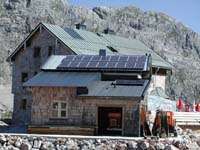Siemens brings high tech to new heights: Alpine huts with environmentally compatible water and power supplies

Siemens is taking high-tech environmental protection to new heights – literally. Serving as a general contractor, Siemens Building Technologies has brought the latest in environmentally compatible technology to the German Alpine Association’s Ingolstaedter Haus, a mountain refuge situated at a height of 2,119 me-ters (6,952 feet) above sea level on the Steinernes Meer plateau of Austria’s Berchtesgadener Alps. Siemens has equipped the hut, built in 1928-29 by the Ingolstadt chapter of the German Alpine Association, with new power and water supply systems and a new biological waste water purification system. Waste water quality has been improved to meet legal requirements, and the water supply has also been upgraded. The hut’s new district heating station is fired by vegetable oil. Solar cells boost the power supply.
But the Ingolstaedter Haus is not alone. Siemens has also furnished other alpine huts with environmentally compatible power and water supply systems.
The new systems for the Ingolstaedter Haus are based on an overall concept which coordinates all technical components and takes into account the extreme environmental conditions prevailing in the high karstic mountains. For example, the hut relies on meltwater and rainwater for its water supply. This represents a major challenge given the 6,000 people using the hut’s facilities every year as overnight guests and, in addition, more people as day visitors. The solution comprises an advanced energy-saving water purification plant and large storage tanks. Numerous filters – using, among other things, quartz grit and activated carbon – and UV degermination help guarantee water purity. Storage tank capacity has been increased to 95 cubic meters from 30 cubic meters.
To ensure that as little precious fresh water as possible is consumed for sanitary purposes, waste water is biologically purified and stored in a separate container. If there is a shortage of water, it can be reused to flush toilets. The rest of the purified water is allowed to seep away and the solid matter remaining is composted. Without this procedure most of the precious, highly purified fresh water would have to be “wasted” for this purpose, which would jeopardize the continuous supply of water. The new system replaces an outdated mode of waste water purification.
The original 24 kilowatt diesel generator has been replaced by a vegetable-oil-fired district heating station with an electricity output of 28 kilowatts and a thermal output of 48 kilowatts. The station employs a motor-driven generator, whose waste heat is reused to produce hot water and to heat the building, thus further improving overall efficiency. It also heats a drying room. The station provides the hut’s basic power supply and produces around 80 percent of its electricity. Solar modules – together with batteries and the requisite rectifiers and inverters – supply the remaining 20 percent.
Facilities such as the aerial goods lift and washing machines, which consume 70 percent of the electricity used in the hut, are supplied with power directly from the district heating station. Small appliances, lighting and sockets and the pumps for water purifycation and the fresh water supply, which consume around 30 percent of the electricity, take most of their power from storage batteries and the solar modules. To maintain power supplies, the hut’s old diesel generator had to operate around ten hours a day. Today, the district power station, fired exclusively with cold-pressed rapeseed oil, needs to run only five to six hours a day.
The project, located “between heaven and earth,” cost ˆ1.1 million. Around ten percent was contributed by the German Alpine Association’s Ingolstadt chapter. The rest came from the Austrian Federal Ministry of Agriculture and Forestry, the Salzburg regional
government, the German environment foundation “Deutsche Bundesstiftung Umwelt” (DBU), the Bavarian Ministry of Development and the Environment, the German Alpine Association and the city of Ingolstadt.
The new power and water supply system for the Ingolstaedter Haus is Siemens’ latest project of this kind. Siemens Building Technologies has also implemented a similar project at another hut owned by the Ingolstadt chapter – the Riemannhaus at a height of 2,177 meters (7,142 feet) on the Steinernes Meer plateau. The same concept has been successfully applied at the Welser Huette owned by the Austrian Alpine Association in the mountains of the Salzkammergut. This year, Siemens is also modernizing the safety systems in several other alpine huts and equipping them with the latest in fire alarm and safety lighting systems.
Source: www.siemens.com/





















